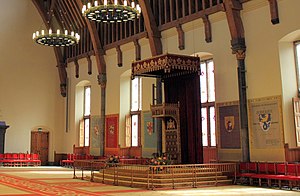
| Part of a series on |
| Orders of succession |
|---|
| Monarchies |
Since 1983, the crown of the Netherlands passes according to absolute primogeniture. From 1814 until 1887, a monarch could only be succeeded by their closest female relative if there were no eligible male relatives. Male-preference cognatic primogeniture was adopted in 1887, though abolished when absolute primogeniture was introduced in 1983. Proximity of blood has been taken into consideration since 1922, when the constitution was changed to limit the line of succession to three degrees of kinship[1] from the current monarch.[2] In a situation where the monarch is succeeded by an eligible aunt or uncle, persons previously excluded could be reintroduced into the line of succession.
In October 2021, in a letter to parliament Prime Minister Mark Rutte stated that the monarch and the heir to the throne could marry a person of the same sex without being forced to abdicate or give up their place in the line of succession.[3]
- ^ Degrees of kinship are counted here according to Roman law, or post-1983 Canon Law: counting the number of births between two people via their common ancestor.
- ^ "Succession". www.koninklijkhuis.nl. Dutch Royal Court. Archived from the original on 22 June 2015. Retrieved 22 December 2013.
The Constitution stipulates that the title to the throne is reserved to blood relatives of the monarch up to the third degree of consanguinity as defined in Dutch law. This means that Prince Maurits and Prince Bernhard will no longer be in the line of succession to the throne. When the Prince of Orange becomes King, the line of succession will start with his children: the Princess of Orange, Princess Alexia and Princess Ariane. Next in line will be Prince Constantijn, then his children and finally Princess Margriet.
- ^ "Love is love: Gay marriage possible for Dutch monarch". Reuters. 12 October 2021. Retrieved 13 October 2021.